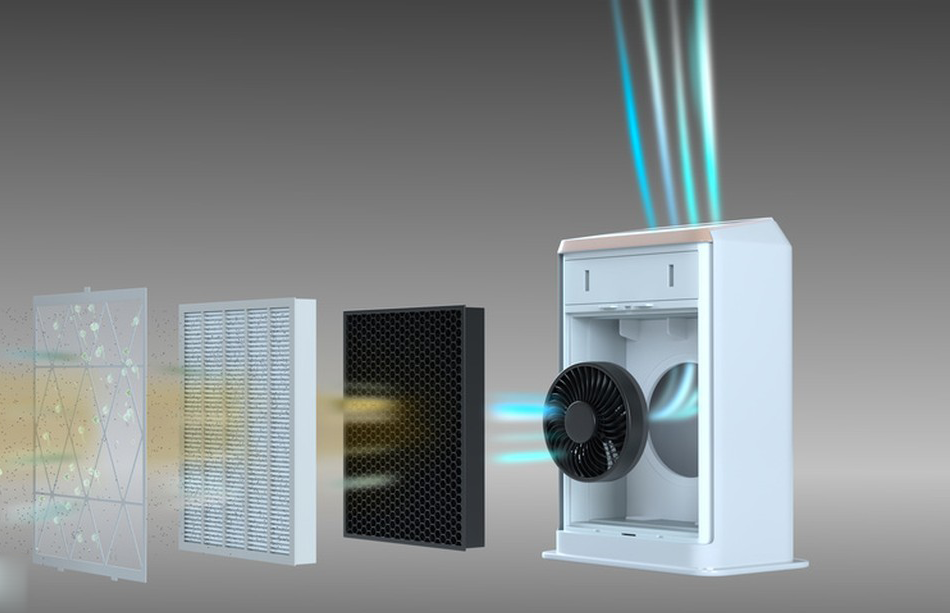In the design and manufacturing of air purifiers, selecting the right cooling fan is crucial to ensuring optimal performance and user experience. There are two main types of fans available in the market: centrifugal fans and axial fans. Understanding the characteristics of these fans and choosing the right one based on the air purifier's operating principles is vital for enhancing purification efficiency, reducing energy consumption, and minimizing noise.
Centrifugal Fan
Working Principle: A centrifugal fan uses a rotating impeller to direct air outward, utilizing centrifugal force to push the airflow to the outer edges. The airflow direction is typically perpendicular to the axis.
Features:
- High Static Pressure: Suitable for high static pressure environments, such as long ducts or systems with filtration devices.
- Higher Noise Levels: Due to air redirection and the high-speed rotation of the impeller, centrifugal fans tend to generate more noise.
- Stable Airflow: Provides steady airflow, making it ideal for situations that require uniform airflow.
Axial Fan
Working Principle: An axial fan moves air directly along the axis of the fan, with airflow parallel to the fan's axis.
Features:
- High Airflow Volume: Capable of delivering large volumes of air, making it ideal for low static pressure environments.
- Lower Noise: Because the airflow direction is along the axis, the structure is simpler, resulting in lower noise levels.
- Simple Design: Axial fans are simpler in design and typically cost less to manufacture.

The Operating Principle of Air Purifiers
The core function of an air purifier is to remove harmful substances from the air through a combination of filters and fans. The fan in an air purifier circulates air, drawing it in and pushing it through multiple layers of filtration, such as HEPA filters and activated carbon filters, which capture particulate matter, bacteria, viruses, and harmful gases. Through this process, the air purifier effectively cleans the indoor air and improves air quality.
However, as the frictional resistance of the filtration system increases, the fan faces greater challenges in terms of working pressure and airflow. This is particularly true for high-efficiency air purifiers, where multiple layers of high-performance filters and activated carbon can significantly increase airflow resistance. Therefore, selecting an efficient, low-noise fan is critical to maintaining optimal purification performance.
Key Factors in Choosing the Right Cooling Fan
- Matching Airflow and PressureThe performance of an air purifier is closely related to the fan's airflow and static pressure. To overcome the high resistance posed by efficient filters, a centrifugal fan, which offers higher static pressure, is often the ideal choice. In contrast, axial fans, while capable of providing high airflow, struggle to deliver the necessary pressure for efficient filtration in high-resistance systems.
- Low Noise and Low Energy ConsumptionIn addition to airflow and pressure, noise control and energy efficiency are also important considerations when selecting a fan. A high-quality fan should not only deliver sufficient pressure under high-resistance filter systems but also feature low noise and low energy consumption. This is especially important for home air purifiers, where noise is a key factor in user comfort. A centrifugal fan with a quiet design can effectively reduce operational noise and enhance the user experience.
- Device Size and Fan InstallationThe design and size of the air purifier influence fan selection. The fan's size and installation method need to be aligned with the available space inside the air purifier. For smaller air purifiers, compact axial fans are typically chosen, while larger devices requiring higher pressure benefit from centrifugal fans.
- Long-Term Stability and DurabilityAir purifiers usually operate continuously for extended periods, so the fan's long-term stability and durability are crucial. Choosing a high-quality fan ensures that the device maintains stable performance over time, reducing the risk of fan failure and performance degradation.
- Duct Design and Airflow OptimizationIn addition to selecting the right fan, the internal airflow design of the air purifier plays a key role in the fan's effectiveness. Proper duct design ensures that the fan efficiently directs air through the filters, while minimizing turbulence and resistance. Therefore, both the fan and the overall device design must prioritize airflow optimization to improve purification efficiency and reduce energy consumption.
Ruiapple Electric’s Expert Fan Selection
With years of experience in fan manufacturing, Ruiapple Electric offers a range of efficient, low-noise, and energy-saving centrifugal and axial fans for air purifier design. We understand that a high-quality fan must excel not only in airflow and pressure but also in noise control, energy efficiency, and reliability. Our fans incorporate advanced noise-reduction technologies and optimized airflow designs, providing superior user experience while ensuring excellent air purification performance.
Selecting the right cooling fan is a critical step in air purifier design. By considering factors such as airflow, pressure, noise, energy efficiency, and the specific characteristics of the filtration system, the best fan can be selected to improve the air purifier’s performance and efficiency. Ruiapple Electric is committed to providing high-quality fan solutions, helping customers design more efficient, energy-saving, and quiet air purifiers to meet the growing demand for air purification technologies.






